The Future of Smartphone Batteries: Why Silicon Is the Game-Changer You’ve Been Waiting For
A New Charge for Your Life: Why This Matters to You
If you’ve ever found yourself anxiously watching your phone battery dip below 10% during a busy day, you’re not alone. Whether you’re navigating unfamiliar streets, responding to work emails, or capturing moments with loved ones, a dying phone can feel like the end of the world. But a major change is on the horizon. Silicon is set to transform the way smartphone batteries work, and it’s going to impact your daily life in a big way. The age of overnight charging and constant power banks might soon be over.
Table of Contents
What’s Wrong with Current Smartphone Batteries?
The Limitations of Lithium-Ion
Right now, your smartphone probably runs on a lithium-ion battery. While reliable, these batteries have serious limitations:
- Slow charging: It often takes 1.5 to 2 hours to fully charge.
- Limited lifespan: Most degrade significantly after 500 to 1000 charge cycles.
- Thermal risks: They can overheat, and in rare cases, even catch fire.
- Environmental concerns: Mining for lithium and cobalt has harsh ecological impacts.
Real-World Frustration
Think about how often you charge your phone in a single day. Frequent recharges, bulky devices to hold larger batteries, and the ever-present fear of overheating—these are issues you’ve probably dealt with. The 2016 Galaxy Note 7 battery recalls are just one example of how problematic lithium-ion tech can be.
Enter Silicon: A Revolution Inside Smartphone Batteries
What Is a Silicon Anode and Why Does It Matter?
Instead of using graphite, silicon-based batteries use a silicon anode. This change might seem small, but it’s revolutionary. Silicon can hold up to 10 times more lithium ions than graphite, which translates to massive benefits for you:
- Longer battery life
- Faster charging
- Less degradation over time
Benefits of Silicon in Smartphone Batteries
Here’s what silicon brings to the table:
- 30-50% increase in battery capacity
- Charging time cut by more than half
- Improved battery health over time
In short, your phone could last all day—and then some—with just one quick charge in the morning.
Backing It Up with Research
Startups like Amprius, Sila Nanotechnologies, and Enovix have already demonstrated the power of silicon batteries in lab settings. According to reports from IEEE Spectrum, silicon anode batteries show a clear edge in energy density and cycle life.


Who’s Leading the Silicon Smartphone Battery Race?
Tech Giants Making Big Moves
You might not realize it, but many of the tech brands you already trust are investing heavily in silicon battery tech:
- Apple: Rumors suggest it is developing custom silicon battery designs.
- Samsung: Has been testing silicon-infused lithium batteries in its R&D labs.
- Google: May incorporate silicon tech in upcoming Pixel models.
Startups and Innovators to Watch
- Sila Nanotechnologies: Supplying materials for next-gen consumer electronics.
- Amprius: Focused on aerospace and military applications, with crossover potential for phones.
- Enovix: Developing 3D silicon lithium-ion batteries, already in pilot production.
The Rollout Timeline
While you may not see these batteries in budget phones right away, flagship devices could start shipping with silicon anodes as early as 2025. Mass adoption is projected to happen between 2026 and 2027.
What This Means for You and Your Phone’s Future
Everyday Improvements You’ll Notice
- No more mid-day charges: Your phone might last 2-3 days on one charge.
- Faster recharge times: Full battery in 30 minutes or less.
- Lighter phones: Smaller batteries free up design space.
- Enhanced performance: More power for demanding apps like video editing or AR.
A Greener Footprint
Switching to silicon doesn’t just help your phone—it helps the planet:
- Longer-lasting batteries = less e-waste
- Reduced mining needs = lower environmental damage
- Easier recycling = more sustainable tech lifecycle
Real-World Tests: What the Data Shows
| Battery Type | Charge Time (0-100%) | Lifespan (Cycles) | Energy Density |
|---|---|---|---|
| Lithium-Ion | 1.5 to 2 hours | ~500–1000 | 250–300 Wh/kg |
| Silicon-Anode | ~30 minutes | ~1200–1500 | 400–500 Wh/kg |
Lab data from companies like Enovix and Sila confirms significant performance gains. Silicon batteries not only charge faster but also last longer and store more energy in smaller packages.
Challenges Still Ahead for Silicon Smartphone Batteries
The Technical Barriers
Despite the hype, silicon batteries aren’t perfect—yet:
- Silicon expansion: It expands and contracts during charging, which can cause cracks.
- Manufacturing costs: More expensive than traditional batteries.
- Scaling: Adapting factory lines to handle new materials takes time.
The Path to Overcoming Hurdles
Innovators are developing solutions like:
- Silicon nanowires: Prevent cracking from expansion.
- Composite materials: Combine silicon with stable elements.
- Cross-industry collaboration: Lessons from aerospace and EV industries are helping fast-track smartphone integration.
FAQ – Smartphone Batteries and the Silicon Revolution
What makes silicon better than graphite in smartphone batteries?
Silicon can store 10x more lithium ions than graphite, which means your phone can last longer and charge faster.
When will silicon batteries become mainstream in smartphones?
You can expect them in premium smartphones around 2025–2027.
Will silicon smartphone batteries cost more?
Initially, yes. But as production scales up, costs will drop—just like they did with lithium-ion.
Are silicon batteries safer?
Yes. Early testing shows improved thermal stability, making them less likely to overheat or catch fire.
Can I replace my current phone battery with a silicon one?
Not yet. These batteries are designed as integrated parts of new devices and require custom phone architecture.
Conclusion: A Smarter Future Starts with Smarter Batteries
The silicon revolution isn’t just another tech upgrade. It’s a shift that promises to make your phone smarter, faster, lighter, and more sustainable. Imagine being able to charge your device once and not worry about it until the next day—or the day after that. Silicon smartphone batteries will make that a reality. As leading brands race to bring this innovation to your pocket, the way you use and depend on your phone will never be the same.
So, stay informed. When it’s time for your next upgrade, make sure you’re choosing a phone that brings you the full power of silicon. Because the future of smartphone batteries isn’t just coming—it’s almost here.


